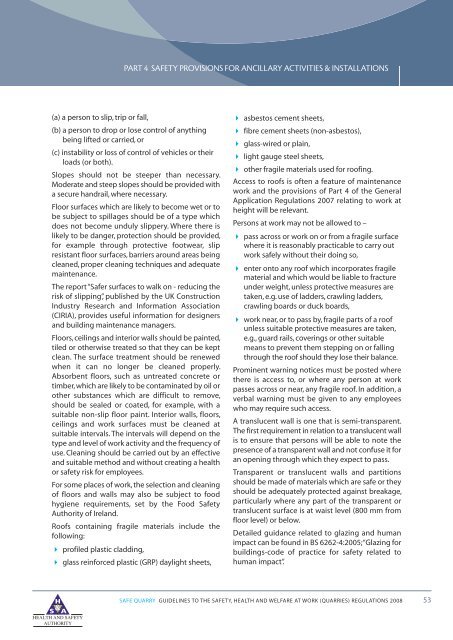Safe Quarry - Health and Safety Authority
Safe Quarry - Health and Safety Authority
Safe Quarry - Health and Safety Authority
Create successful ePaper yourself
Turn your PDF publications into a flip-book with our unique Google optimized e-Paper software.
PART 4 SAFETY PROVISIONS FOR ANCILLARY ACTIVITIES & INSTALLATIONS<br />
(a) a person to slip, trip or fall,<br />
(b) a person to drop or lose control of anything<br />
being lifted or carried, or<br />
(c) instability or loss of control of vehicles or their<br />
loads (or both).<br />
Slopes should not be steeper than necessary.<br />
Moderate <strong>and</strong> steep slopes should be provided with<br />
a secure h<strong>and</strong>rail, where necessary.<br />
Floor surfaces which are likely to become wet or to<br />
be subject to spillages should be of a type which<br />
does not become unduly slippery. Where there is<br />
likely to be danger, protection should be provided,<br />
for example through protective footwear, slip<br />
resistant floor surfaces, barriers around areas being<br />
cleaned, proper cleaning techniques <strong>and</strong> adequate<br />
maintenance.<br />
The report“<strong>Safe</strong>r surfaces to walk on - reducing the<br />
risk of slipping”, published by the UK Construction<br />
Industry Research <strong>and</strong> Information Association<br />
(CIRIA), provides useful information for designers<br />
<strong>and</strong> building maintenance managers.<br />
Floors, ceilings <strong>and</strong> interior walls should be painted,<br />
tiled or otherwise treated so that they can be kept<br />
clean. The surface treatment should be renewed<br />
when it can no longer be cleaned properly.<br />
Absorbent floors, such as untreated concrete or<br />
timber, which are likely to be contaminated by oil or<br />
other substances which are difficult to remove,<br />
should be sealed or coated, for example, with a<br />
suitable non-slip floor paint. Interior walls, floors,<br />
ceilings <strong>and</strong> work surfaces must be cleaned at<br />
suitable intervals. The intervals will depend on the<br />
type <strong>and</strong> level of work activity <strong>and</strong> the frequency of<br />
use. Cleaning should be carried out by an effective<br />
<strong>and</strong> suitable method <strong>and</strong> without creating a health<br />
or safety risk for employees.<br />
For some places of work, the selection <strong>and</strong> cleaning<br />
of floors <strong>and</strong> walls may also be subject to food<br />
hygiene requirements, set by the Food <strong>Safe</strong>ty<br />
<strong>Authority</strong> of Irel<strong>and</strong>.<br />
Roofs containing fragile materials include the<br />
following:<br />
profiled plastic cladding,<br />
glass reinforced plastic (GRP) daylight sheets,<br />
asbestos cement sheets,<br />
fibre cement sheets (non-asbestos),<br />
glass-wired or plain,<br />
light gauge steel sheets,<br />
other fragile materials used for roofing.<br />
Access to roofs is often a feature of maintenance<br />
work <strong>and</strong> the provisions of Part 4 of the General<br />
Application Regulations 2007 relating to work at<br />
height will be relevant.<br />
Persons at work may not be allowed to –<br />
pass across or work on or from a fragile surface<br />
where it is reasonably practicable to carry out<br />
work safely without their doing so,<br />
enter onto any roof which incorporates fragile<br />
material <strong>and</strong> which would be liable to fracture<br />
under weight, unless protective measures are<br />
taken, e.g. use of ladders, crawling ladders,<br />
crawling boards or duck boards,<br />
work near, or to pass by, fragile parts of a roof<br />
unless suitable protective measures are taken,<br />
e.g., guard rails, coverings or other suitable<br />
means to prevent them stepping on or falling<br />
through the roof should they lose their balance.<br />
Prominent warning notices must be posted where<br />
there is access to, or where any person at work<br />
passes across or near, any fragile roof. In addition, a<br />
verbal warning must be given to any employees<br />
who may require such access.<br />
A translucent wall is one that is semi-transparent.<br />
The first requirement in relation to a translucent wall<br />
is to ensure that persons will be able to note the<br />
presence of a transparent wall <strong>and</strong> not confuse it for<br />
an opening through which they expect to pass.<br />
Transparent or translucent walls <strong>and</strong> partitions<br />
should be made of materials which are safe or they<br />
should be adequately protected against breakage,<br />
particularly where any part of the transparent or<br />
translucent surface is at waist level (800 mm from<br />
floor level) or below.<br />
Detailed guidance related to glazing <strong>and</strong> human<br />
impact can be found in BS 6262-4:2005;“Glazing for<br />
buildings-code of practice for safety related to<br />
human impact”.<br />
SAFE QUARRY GUIDELINES TO THE SAFETY, HEALTH AND WELFARE AT WORK (QUARRIES) REGULATIONS 2008 53
















